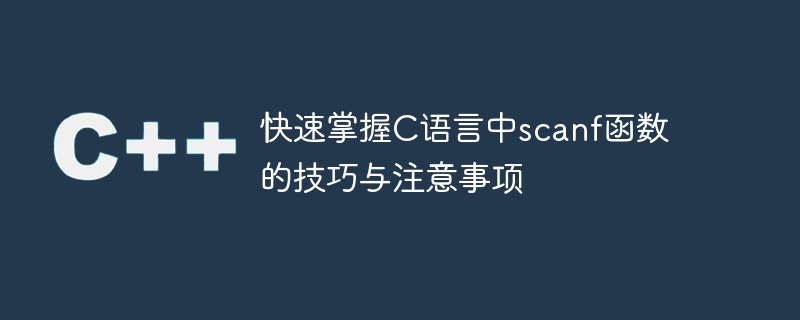

Quickly master the skills and precautions of the scanf function in C language
In C language, the scanf function is a function used to read data from the standard input. It can read many types of data, such as integers, floating point numbers, characters, etc. Mastering the skills and precautions for using the scanf function will help you process input more efficiently and improve the quality and reliability of your code. The following will introduce some tips and precautions about the scanf function, and give specific code examples.
Tip 1: Check the return value of the scanf function
When the scanf function reads data, it will return the number of successfully read parameters. When using the scanf function, you should always check its return value to ensure that data input was successful. If the return value is not equal to the expected number of parameters, it means that the input is wrong and you may need to re-enter or handle the corresponding exception.
Code sample:
int num;
if (scanf("%d", &num) != 1) {
printf("输入有误,请重新输入整数
");
return;
}Tip 2: Clean the input buffer
When using the scanf function to read characters or strings, you may encounter A situation where residual characters cause input to be skipped. To clean the input buffer, you can use the getchar function to read and discard residual characters until a newline character is read.
Code example:
char ch; while ((ch = getchar()) != ' ' && ch != EOF);
Tip 3: Safely use %s to read strings
When using the scanf function to read a string, you should pay attention to the length of the string to Avoid overflow. You can limit the length of the string by specifying the maximum number of characters to read in the %s format control character. At the same time, when using %s to read a string, it will automatically stop reading when it encounters whitespace characters (spaces, tabs, newlines, etc.), so there is no need to additionally process the end mark of the string.
Code example:
char str[20];
scanf("%19s", str); // 最多读取19个字符到str中,避免溢出Tip 4: Use the correct format control character
When using the scanf function, you should use the correct format control character consistent with the type of input data match to avoid reading incorrect data. For example, if you want to read a floating point number, you should use the %f format control operator instead of the %d format control operator.
Code example:
float num;
scanf("%f", &num); // 读取一个浮点数到num中Note 1: Separator between input data
When using the scanf function to read multiple input data, you need to pay attention to the difference between the input data separator between. By default, the scanf function separates input data by whitespace characters (spaces, tabs, newlines, etc.). If there are other characters as delimiters between input data, the corresponding characters need to be specified in the format control character.
Code example:
int num1, num2;
scanf("%d,%d", &num1, &num2); // 读取两个整数,用逗号分隔Note 2: The order of use of format control characters
When using the scanf function to read multiple input data, you need to follow the order of the input data Use format control characters. This ensures that the data is read in the correct order. If the order of format control characters is inconsistent with the order of input data, the input data may be confused.
Code example:
int num1, num2;
scanf("%d %d", &num2, &num1); // 读取两个整数,注意顺序In summary, mastering the skills and precautions for using the scanf function will enable you to process input more efficiently. In applications, these tips and precautions can be combined according to specific needs to write more robust and reliable code. I hope this article can inspire readers and improve their ability to use the scanf function in C language.
The above is the detailed content of Tips and precautions for using scanf function in C language. For more information, please follow other related articles on the PHP Chinese website!




